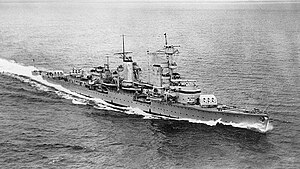| Revision as of 15:53, 20 May 2006 editCosal (talk | contribs)Extended confirmed users5,579 editsm →External links: falsche Links entfernt← Previous edit | Revision as of 01:33, 27 May 2006 edit undoKurt Leyman (talk | contribs)Extended confirmed users5,123 edits ReformatingNext edit → | ||
| Line 42: | Line 42: | ||
| |- | |- | ||
| |Armament: | |Armament: | ||
| | |
|9 x 150 mm (5.9 inch)<br>6 x 88 mm<br>8 x 37 mm<br>8 x 20 mm (later 18)<br>12 x 533mm torpedo tubes<br>120 ] | ||
| |- | |- | ||
| |Aircraft: | |Aircraft: | ||
Revision as of 01:33, 27 May 2006

| |
| Career | Kriegsmarine Jack |
|---|---|
| Class | Königsberg |
| Commissioned: | January 1930 |
| Fate: | Sunk on 3 March 1945 |
| General Characteristics | |
| Displacement: | 8350 tons full load |
| Length: | 174 m |
| Beam: | 15.3 m |
| Draught: | 6.28 m |
| Propulsion: | 2 steam turbines, 6 boilers, + 2 MAN diesel, 2 shafts, 69 800 shp |
| Speed: | 32 knots |
| Range: | 7300 nm at 17 knots |
| Complement: | 850 |
| Armament: | 9 x 150 mm (5.9 inch) 6 x 88 mm 8 x 37 mm 8 x 20 mm (later 18) 12 x 533mm torpedo tubes 120 mines |
| Aircraft: | 2 Arado 196 floatplanes |
Köln was a German light cruiser prior to and during World War II, one of three K-Class cruisers named after cities starting with the letter K. This ship was named after the city of Köln (Cologne). The others in her class were the Königsberg and the Karlsruhe. The K-class cruisers were designed in the 1920s and built in accordance to the 6,000 ton limit for cruisers imposed on Germany by the Treaty of Versailles. To stay within this limit, 85% of the ships were welded instead of bolted. This caused problems, as the welding did not withstand the stress of long-term journeys as well as had been hoped.
Combat history
Köln patrolled Spanish waters during the Spanish Civil War. During World War II she participated in Baltic operations and in the Invasion of Norway (Operation Weserübung). After the invasion of Norway the ship undertook primarily mining operations and attacks on Allied convoys. In February 1943, after a submarine attack, the heavy cruiser Admiral Hipper and Köln had to be withdrawn from service for extensive repairs. Köln remained out of service from March 1943 to March 1944 when she was recommissioned to train cadets. On December 12, 1944 she was heavily damaged in a bombing raid, the power stations and starboard engine both being destroyed. Köln then sailed for Wilhelmshaven for repairs. She arrived at Wilhelmshaven in February 1945 and suffered through two more bombing raids. Köln was severely damaged in the final night of British bombing of the port on March 3 1945. The ship sank on even keel. The turrets remained above water and continued to shell the oncoming Allied advance. The Köln was scrapped in 1946.
External links
